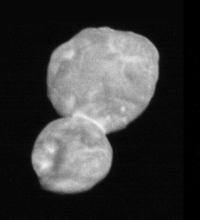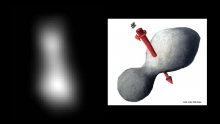Listen to today's episode of StarDate on the web the same day it airs in high-quality streaming audio without any extra ads or announcements. Choose a $8 one-month pass, or listen every day for a year for just $30.
You are here
Distant Merger
Billions of years ago, when the solar system was young, two mountain-sized agglomerations of ice and rock staged a gentle merger. Combined, they look a bit like a flat cookie with a small scoop of ice cream along its rim.
The combined object is known formally as 2014 MU69, and informally as Ultima Thule. It’s in the Kuiper Belt — a wide zone beyond the orbit of Neptune, the Sun’s most remote major planet. The belt contains millions of chunks of ice and rock.
Ultima Thule is the second member of the belt studied by the New Horizons spacecraft. The first was Pluto. Ultima Thule is a billion miles farther from the Sun than Pluto. And it’s a lot smaller and much less active.
The object is known as a “contact binary.” It consists of two parts, which were born separately but close together. They soon became linked by gravity, forming a pair. They then moved closer together until they made contact. The contact was gentle enough to not blast them to bits, but strong enough to fuse them together.
The combined object is more than 20 miles long. It’s quite dark, and quite red — perhaps the result of billions of years of exposure to radiation. There aren’t many craters on the surface. But New Horizons did see evidence of frozen water and other compounds.
It’ll take the better part of a year for New Horizons to transmit the rest of its observations to Earth — giving us an even better view of the most distant object ever visited by a spacecraft.






